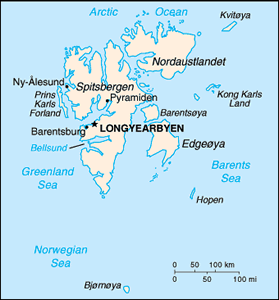The Geography of Svalbard
The Geography of Svalbard
Geography
Location: Northern Europe, islands between the Arctic Ocean, Barents Sea, Greenland Sea, and Norwegian Sea, north of Norway
Geographic coordinates: 78 00 N, 20 00 E
Map references: Arctic Region
Area: total: 61,020 sq km land: 61,020 sq km water: 0 sq km note: includes Spitsbergen and Bjornoya (Bear Island)
Area - comparative: slightly smaller than West Virginia
Land boundaries: 0 km
Coastline: 3,587 km
Maritime claims: territorial sea: 4 nm exclusive fishing zone: 200 nm unilaterally claimed by Norway but not recognized by Russia
Climate: arctic, tempered by warm North Atlantic Current; cool summers, cold winters; North Atlantic Current flows along west and north coasts of Spitsbergen, keeping water open and navigable most of the year
Terrain: wild, rugged mountains; much of high land ice covered; west coast clear of ice about one-half of the year; fjords along west and north coasts
Elevation extremes: lowest point: Arctic Ocean 0 m highest point: Newtontoppen 1,717 m
Natural resources: coal, iron ore, copper, zinc, phosphate, wildlife, fish
Land use: arable land: 0% permanent crops: 0% other: 100% (no trees; the only bushes are crowberry and cloudberry) (2005)
Irrigated land: NA
Natural hazards: ice floes often block the entrance to Bellsund (a transit point for coal export) on the west coast and occasionally make parts of the northeastern coast inaccessible to maritime traffic
Environment - current issues: NA
Environment - international agreements:
Geography - note: northernmost part of the Kingdom of Norway; consists of nine main islands; glaciers and snowfields cover 60% of the total area; Spitsbergen Island is the site of the Svalbard Global Seed Vault, a seed repository established by the Global Crop Diversity Trust and the Norwegian Government


